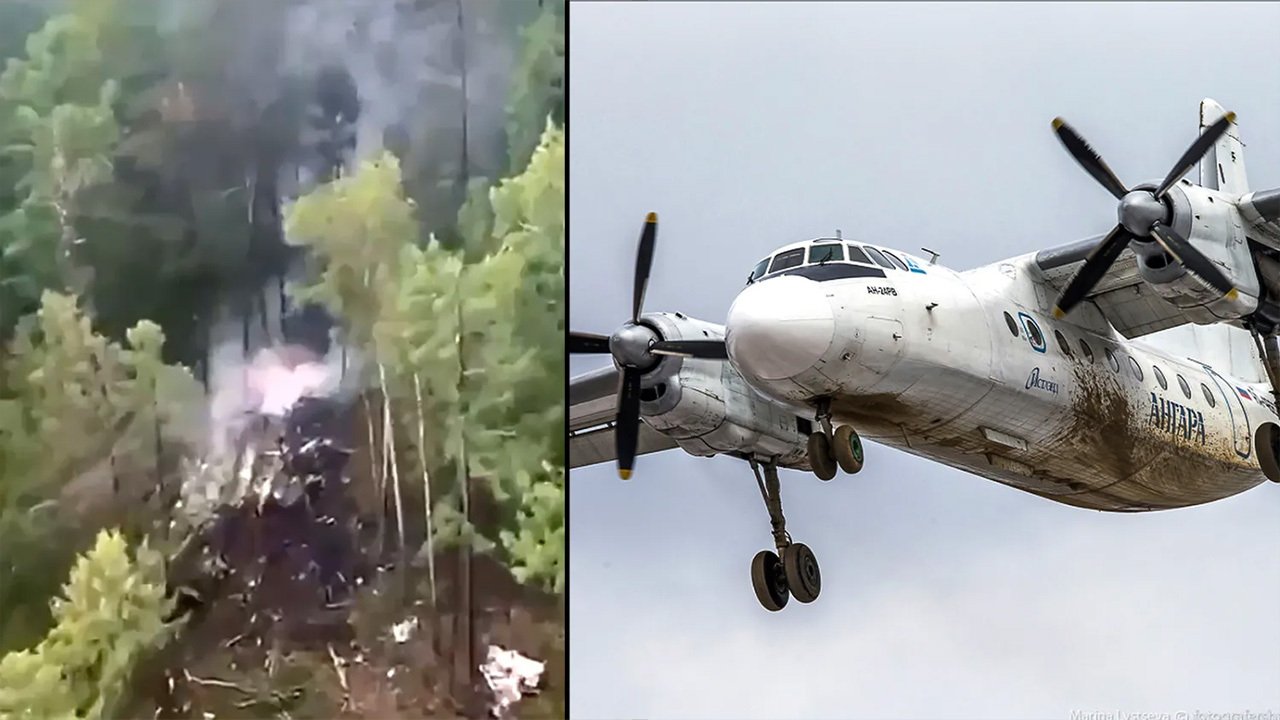Tynda, Russia — A chilling video circulating on Russian social media captures the last moments before an Angara Airlines An-24 plane crashed into the remote mountains of the Amur region, claiming the lives of all 49 people on board.
The twin-engine aircraft vanished from radar around 1:00 PM local time on Thursday, July 24, 2025, while attempting to land at Tynda Airport amid heavy rain and low visibility. The footage shows the plane flying perilously low—just above treetop level—during its final approach.
Despite the severe weather, the pilots did not report any mechanical failures or emergencies before losing contact with air traffic control. Shortly after, a Mi-8 helicopter from Russia’s Ministry of Emergency Situations spotted the wreckage on a steep, forested slope roughly 16 kilometers from Tynda, with thick black smoke billowing from the taiga below.
“A helicopter from the Federal Air Transport Agency located the burning fuselage during the search operation,” the ministry said in a statement. “Rescue teams are being deployed despite the lack of road access.”
Over 100 responders were dispatched, using heavy machinery to cut through the rugged terrain. Tragically, no survivors were found.
Among the Victims: Prominent Doctors and a Teenage Boy
The passenger list included several medical professionals, among them Dr. Leonid Maizel, a 71-year-old thoracic surgeon from Khabarovsk Regional Clinical Hospital. Reports indicate he was traveling with his colleague, gynecologist Dr. Galina Naidyonova, her husband, Dr. Alexey Naidyonov (a diagnostics specialist), and their 14-year-old grandson—all presumed dead.
Also on board were primary school teacher Elena Velikanova and Natalia Shiyan, a chemical and biological technologist.
The flight had originated in Khabarovsk, stopped briefly in Blagoveshchensk, and was en route to Tynda—a remote town of about 30,000 near the Chinese border, more than 5,000 kilometers east of Moscow.
Aging Soviet-Era Plane Under Scrutiny
The ill-fated aircraft, tail number RA-47315, was manufactured in 1976 during the Soviet era. Originally operated by state-run Aeroflot, it was later acquired by Angara Airlines, a Siberian carrier.
According to RussianPlanes.net, Angara still operates 10 An-24s built between 1972 and 1976. Last year, the airline reportedly sought government approval to extend the operational life of its Antonov fleet amid Western sanctions that have restricted access to modern aircraft.
Though the plane had passed a routine inspection at Blagoveshchensk’s Ignatyevo Airport, aviation experts have long warned about the risks of flying outdated Soviet-era planes without upgrades.
“These aircraft haven’t had avionics modernization in decades,” Russian test pilot Vadim Bazykin told reporters. “If we can’t upgrade them, we shouldn’t be flying them. Gambling with lives like this is reckless.”
Criminal Investigation Launched
Authorities have opened a probe into possible aviation safety violations. The An-24, once nicknamed the “flying tractor” for its rugged performance in Siberia, was designed to land on unpaved runways and endure extreme cold—but maintenance challenges have grown with age.
The crash has intensified concerns over Russia’s reliance on aging aircraft, particularly as sanctions strain the aviation industry’s access to spare parts and foreign-made planes.
As investigators piece together the cause, the nation mourns yet another aviation tragedy in its vast eastern wilderness—made all the more haunting by the footage of the plane’s final, futile struggle against the storm.
Sources: The Guardian, Daily Mail, Russian Ministry of Emergency Situations, RussianPlanes.net
Giostanovlatto – Bali Today





